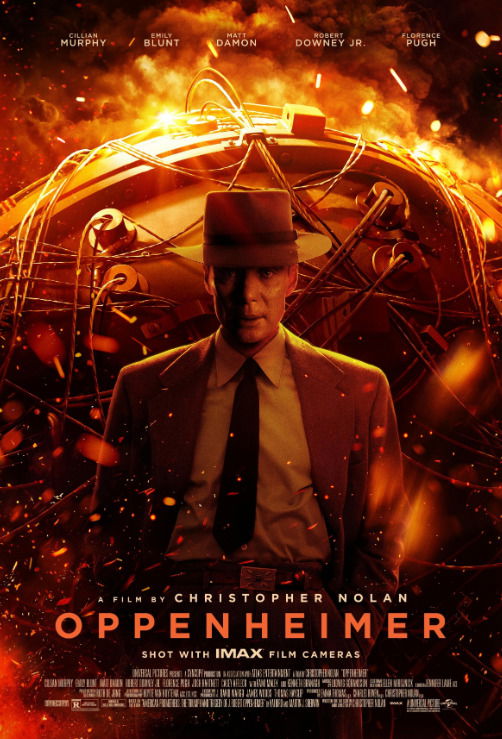“Overwrought Historical Warnings”

| None | Light | Moderate | Heavy | |
|---|---|---|---|---|
| Language | ||||
| Violence | ||||
| Sex | ||||
| Nudity |
What You Need To Know:
Director Christopher Nolan’s OPPENHEIMER is very well acted. However, several scenes are annoyingly overwrought. The move’s non-linear narrative structure gets confusing in places. The movie’s most fascinating section is the one in Los Alamos leading up to the explosion of the test atomic bomb and its aftermath. However, OPPENHEIMER has a strong secular humanist worldview with unjust politically correct depictions of anti-communists who disagreed with Oppenheimer about nuclear policy. Finally, it has excessive foul language and two sex scenes with explicit nudity.
Content:
(HH, CoCo, PP, C, B, PCPC, RHRH, FR, LLL, V, SS, NN, AA, D, M):
Strong humanist worldview in historical movie about a communist sympathizing American scientist who managed the American program to develop the two atomic dropped on Japan during World War II, with some images of and references to American patriotism (especially during scenes featuring the successful explosion of a test bomb and the end of the War with Japan), plus images of crosses and churches and references to faith as the military builds and creates the town where the scientists developing the atomic bomb will live with their families, but the movie serves mostly to provide a big secular warning to viewers about the dangers of nuclear weapons to destroy the whole planet and to promote a politically correct attack against anti-communism and people who support it, in a revisionist history manner that has some false content, plus the title character quotes a Hindu text that he uses as a metaphor for the destructive power of atomic bombs, especially massive thermonuclear devices;
About 23 obscenities (including at least 10 “f” words), two Jesus profanities and three GD profanities;
Images of an atomic bomb exploding, an image of fire spreading around the Earth, and woman tries suicide by sticking her head under water in a tub, but she stops ,but then she sticks her head in again (a gloved arm seems to reach out to help her – there are suspicions that a Soviet spy assassinated her because she was the on and off mistress of a famous nuclear scientists in America, but the movie doesn’t mention this), and it is reported that the woman died;
Two depicted scenes of adulterous sex with some explicit nudity;
Images of upper female nudity and upper male nudity during depicted sex scenes and the second scene is shown in a flashback during a Congressional hearing, and the camera cuts back to the hearing where the man is being questioned, and he is nude so an image of upper male nudity is shown;
Some alcohol use and a mother is drunk when her husband comes home from work and she’s frazzled and drunk because their baby has been crying all day;
Smoking but no drugs; and,
Villain is vindictive and manipulative.
More Detail:
The plot to OPPENHEIMER is divided into two main sections, with scenes from his private life. The two sections are intertwined throughout the movie, which leads to some confusion, even though one of the sections is shot in black and white.
The first section, shot in color, involves the development of the atomic bomb and its aftermath, including Robert Oppenheimer’s early career where he became interested in nuclear physics. The movie goes on from there to show how Oppenheimer became more and more prominent in America. Robert had gone to Europe to learn from some of the great scientific geniuses in nuclear physics and quantum mechanics. He returns to America to bring the new theories about quantum mechanics to the United States. Along the way, however, he has an affair with another man’s wife and, later, resumes the affair, even though he has gotten married, and his wife has a baby boy.
While working at Berkeley University in California in the late 1930s, Robert started dabbling in leftwing politics, including a union movement at the college that included overt communists. The young founder and head of a laboratory warns Oppenheimer about the union meetings, but Robert didn’t break off his other leftwing, communist ties. His own brother, Frank, was a member of the Communist Party. Like many at that time, Robert gave money to support the resistance to the fascists in the Spanish Civil War.
Eventually, when America joins World War II after the Japanese bombing of Pearl Harbor on Dec. 7, 1941, Oppenheimer starts working with other scientists on how to construct a working atomic bomb. Then, in October 1942, Brigadier General Leslie Graves asks Robert to manage the Manhattan Project, the actual name for America’s program to develop the bomb. Robert convinces Graves to establish a team of top scientists and their families at Los Alamos, New Mexico, near a ranch Robert and his brother had leased and purchased in the late 1920s when Robert came down with a mild case of tuberculosis.
This starts what is definitely the movie’s best part, which follows the progress of the development of the atomic bomb, the detonation of a test bomb and the decision by President Truman to attack Hiroshima and Nagasaki with it. Robert becomes conflicted, however, about his part in developing the bomb and clashes with the brilliant Los Alamos scientist Edward Teller, a strong anti-communist from Hungary, who wants to develop a thermonuclear weapon called “The Super” or “The Hydrogen Bomb.” The American government becomes anxious to develop this bomb when the news breaks that the Soviet Union, led by the ruthless communist dictator Joseph Stalin, has just developed its own atomic bomb.
The movie’s second part is shot in black and white. It mostly concerns a lengthy, closed door Congressional hearings in 1954 over whether Robert should retain his security clearance with the Atomic Energy Commission. The movie depicts the hearings as unfair and led by deceitful, unjust and even vindictive men who are strong anti-communists. Later, the scenes show the vindictive man who manipulated and engineered the month-long 1954 hearings getting his comeuppance in 1959 when the United States Senate votes to deny him a major cabinet post with President Eisenhower’s administration. Viewers are supposed to cheer when the movie informs them that John F. Kennedy was one of the Senators who voted no. Scenes from this second part are depicted throughout the rest of the movie, which begins in 1925.
For the most part, acclaimed director Christopher Nolan’s OPPENHEIMER is very well acted. However, several scenes are annoyingly overwrought, especially a scene where the prosecutor starts angrily yelling questions at Oppenheimer, who starts to have an emotional breakdown. Also, the movie’s concluding, emotional images warning that nuclear weapons can destroy the Earth is also overwrought. Tell us something we didn’t know, Christopher.
The movie is also sometimes a bit confusing. Much of that is due to the nonlinear way in which the movie’s story is revealed. Early, for instance, the movie introduces important people without letting viewers know who, exactly, these people are. Then, zip, the movie’s off to another time and place with some more new people.
The movie’s most successful, most fascinating section is the one in Los Alamos leading up to the successful explosion of the test atomic bomb and its immediate aftermath. It makes one wish Christopher Nolan had just told his story in sequence, without all the flashbacks and flash forwards.
Ultimately, OPPENHEIMER is making two points. First, it’s giving viewers a scary secular warning about the power of nuclear weapons to destroy the Earth in a fiery conflagration. Second, it’s giving viewers a warning about the dangers of the misuse of government power.
The second point is sadly couched in the context of a politically correct attack against anti-communism. As a result, the anti-communist villains in the movie, scientist Edward Teller, the prosecutor and especially Oppenheimer’s Machiavellian nemesis come across as jerks. As a result, the movie’s anti anti-communism comes off as too pat, a contradictory ham-fisted setup. Earlier in the movie, it’s okay for Oppenheimer and everybody to hate Nazi Germany and Imperial Japan, but, when the late 1940s roll around, it’s really bad to be so concerned about communist tyrant Joseph Stalin getting his grubby hands on nuclear weapons. Suddenly, mass destruction isn’t so popular, and leftists like Robert Oppenheimer grow a conscience. It’s especially annoying that the vindictiveness of Oppenheimer’s anti-communist nemesis is condemned, but the vindictiveness of Oppenheimer’s wife against Teller is lauded.
The first point, about the power of nuclear weapons, comes across as silly utopian fear mongering. Such fear mongering didn’t work in the 1970s and 1980s. And, 60 years after Stanley Kubrick’s comic masterpiece, DR. STRANGELOVE, which is titled “How I Learned to Stop Worrying and Love the Bomb,” it seems terribly outdated and cliched.
OPPENHEIMER also contains excessive foul language, including at least 10 “f” words and five strong profanities. It also has two lewd sex scenes with explicit nudity. Both kinds of content are a sure way to limit the potential audience for the movie. Don’t the filmmakers, producers and distributors want their movie to be seen by older children and teenagers? Guess not.
In reality, more and more evidence of Robert Oppenheimer’s connections to communist agitators has been revealed. In fact, it now seems certain that Oppenheimer, though he didn’t actually spy for the Soviet Union, was part of a “closed unit” of the Communist Party’s professional section in Berkeley from 1937 to 1942. As we now know, the Communist Party in the United States got its marching orders directly from Moscow in the Soviet Union.


 - Content:
- Content: 

